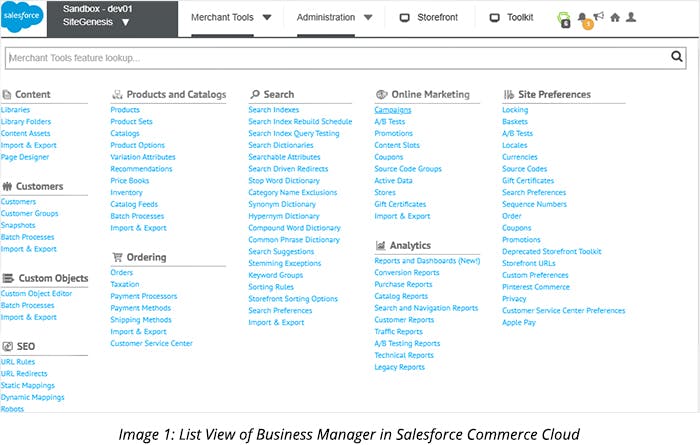What Is Salesforce B2B Commerce and Its B2B Alternatives?

Salesforce B2B Commerce provides unique advantages with its reliable brand and integrations with other Salesforce products.
Salesforce B2B Commerce also includes many features that users may find unnecessary, without the ability to customize what they pay for.
Other alternatives to Salesforce B2B Commerce include fabric, BigCommerce, and Adobe Commerce, all of which are worth considering.
fabric Commerce Platform delivers a suite of e-commerce products that can be implemented as a complete end-to-end platform or as a scale-as-you-grow solution.
Salesforce B2B Commerce is a business-to-business (B2B) commerce platform. Salesforce B2B Commerce has its roots with Demandware, an e-commerce software company it purchased in 2016. Soon after the acquisition, Salesforce began offering Demandware’s platform under its own brand name.
Salesforce is an established name across B2B sales and e-commerce. Because its software is based on established technology, many users trust Salesforce and believe it will easily integrate with their other e-commerce applications.
But the platform’s monolithic structure means users don’t have the flexibility they would on a microservices-based platform. That’s why it’s essential to consider the advantages, disadvantages, and alternatives to Salesforce B2B Commerce.
[toc-embed headline=”Salesforce B2B Commerce Features”]
Salesforce B2B Commerce Features
Advantages of Salesforce B2B Commerce
When Salesforce purchased Demandware for $3 billion and took on its e-commerce platform, it became a leader in the field. Salesforce’s past as a leader in other B2B software combined with its acquisition of this established platform made Salesforce B2B Commerce a safe choice for those who already trusted its brand.
Its integrations with Salesforce’s CRM and other applications are also appealing to users. Customers with a suite of enterprise applications often have trouble getting the programs to communicate with one another, but two products built by the same company will feature easy and fast integrations.
Disadvantages of Salesforce B2B Commerce
While Salesforce may have been at the cutting edge of e-commerce software when it made the Demandware acquisition, it has lost that place to more innovative companies. The biggest drawback to Salesforce B2B Commerce is its monolithic architecture and lack of microservices.
Headless commerce has become increasingly important in the last few years. Separating the frontend from the backend in this way is possible in Salesforce, but its monolithic architecture still leaves some drawbacks that going headless by itself can not resolve.
Instead, many companies have been moving to microservices on their e-commerce backend. This strategy is usually best for enterprise-sized companies, while smaller businesses can find what they need in more monolithic platforms.
While companies using microservices find flexibility, Salesforce B2B Commerce’s users pay for a wide range of features that may not all fit their use case. Unless an organization is already using Salesforce, it’s excessive to purchase Salesforce as a CRM to make B2B Commerce work with the platform.
Bundling B2B Commerce with Salesforce’s CRM also builds in a high cost and a long contract, with an implementation that can often cost more than $250,000 and commit the user to three to five years of use. The end result is a platform that can also be difficult to integrate with third-party tools, creating further obstacles for users that don’t exclusively use Salesforce’s services.

Furthermore, while its CRM got a significant facelift with Salesforce Lightning Edition, Salesforce B2B Commerce is still full of long menus that many find challenging to navigate.
[toc-embed headline=”Salesforce B2B Commerce Alternatives”]
Salesforce B2B Commerce Alternatives
fabric
fabric offers a cutting-edge B2B Commerce Platform with a microservices architecture that gives it flexibility unavailable to those using traditional, monolithic platforms. Its intuitive user interface reduces training costs, and its product information management (PIM) and subscription functionality make product management and recurring orders easy to implement.
BigCommerce
BigCommerce is an older, established e-commerce platform. It facilitates headless e-commerce with its easy-to-use interface and integrations with other tools. However, it is a monolithic platform that can lack the flexibility many users look for now. For that reason, it’s becoming more and more common to migrate from BigCommerce to microservices-based e-commerce.
Adobe Commerce
Adobe Commerce has the advantage of extensive integrations with other products and features like customer-specific pricing. However, the platform doesn’t include PIM software or digital payment options, which can dissuade customers looking for those features.

Product management @ fabric. Previously b2b e-commerce @ Shipwire, Fiserv, Zong, and Google.